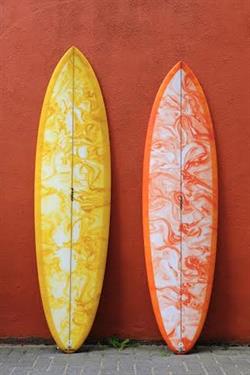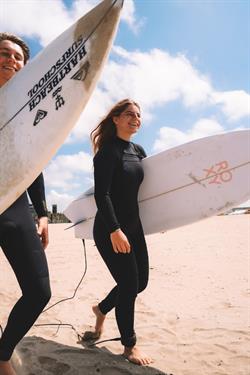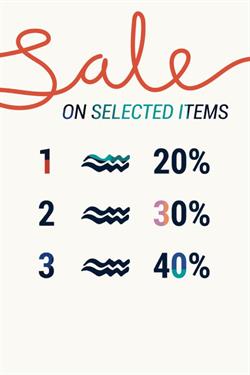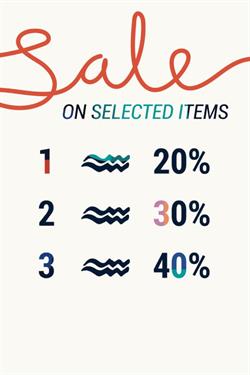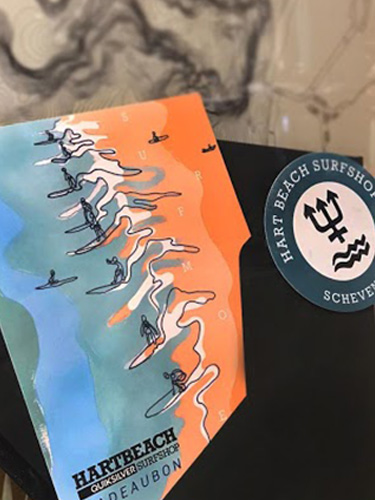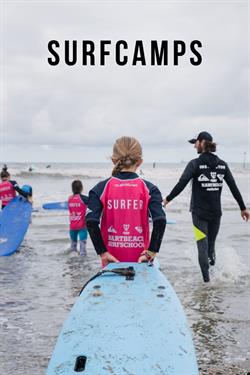Neoprene
All wetsuits are made of the same kind of fabric called Neoprene. This material is a form of rubber, discovered in the 1930s while scientists in America were trying to make new kinds of manufacturing materials. Neoprene is a synthetic rubber that has some pros in comparison to natural rubber. It is way resistant to water, oils, and heat. This means that neoprene has better isolating properties.
Neoprene meets the aquatic sports
 ">
">
When surfing became more popular in the 1960s, surfers were looking for a suit that could keep them warm in cold waters. Some of them are starting experimenting with Neoprene, and so the first neoprene suit was made. Hugh Brander, a physicist at Berkeley university, founded Neoprene foam; Neoprene with small pockets of air in the fabric. The neoprene fabric tolerates a brief bit of water between the skin and the rubber. The air pockets in the material will make sure that the tiny layer of water warms up to body temperature very quickly.
At the same moment,
Jack O'Neill was looking for material to make a suit, so that (in his own words) his Balls wouldn't freeze off. He got air of the Neoprene foam material that would thermally insulate in cold waters and designed the first wetsuit.
Nowadays, the experimentation on the material is still going on within the different wetsuits brands. Neoprene has been mixed with Spandex and acrylics to make the wetsuit more flexible. Every brand has their own kind of Neoprene variation that makes their wetsuits special. For instance, the
Flash bomb material of Rip Curl or the Furnace of Billabong. Not only the neoprene, but the lining, stitching, and patching has developed over the last decade.
Different Season, Different Wettie.
There is a big difference if you want to surf on the North-pole or the Bahamas, when you choose your wetsuit. Even as Dutchies, we have different wetsuits for different seasons. It's best to make a choice on water temperature and therefore the thickness of the Neoprene. Let's take Holland for example. A Dutch surfer uses;
The water temperature goes hand in hand with the thickness of your wetsuit. Of course the air temperature too, but not as much. The thickness of a wetsuit is indicated with two numbers. The first one tells you the thickness of the neoprene on the chest and back. It's most important to isolate your body on those two parts. The second number is the thickness of your arms and legs. The Neoprene is normally less thick on the ligaments, so that there will be no loss of flexibility and movement.
When it fits. It sits.
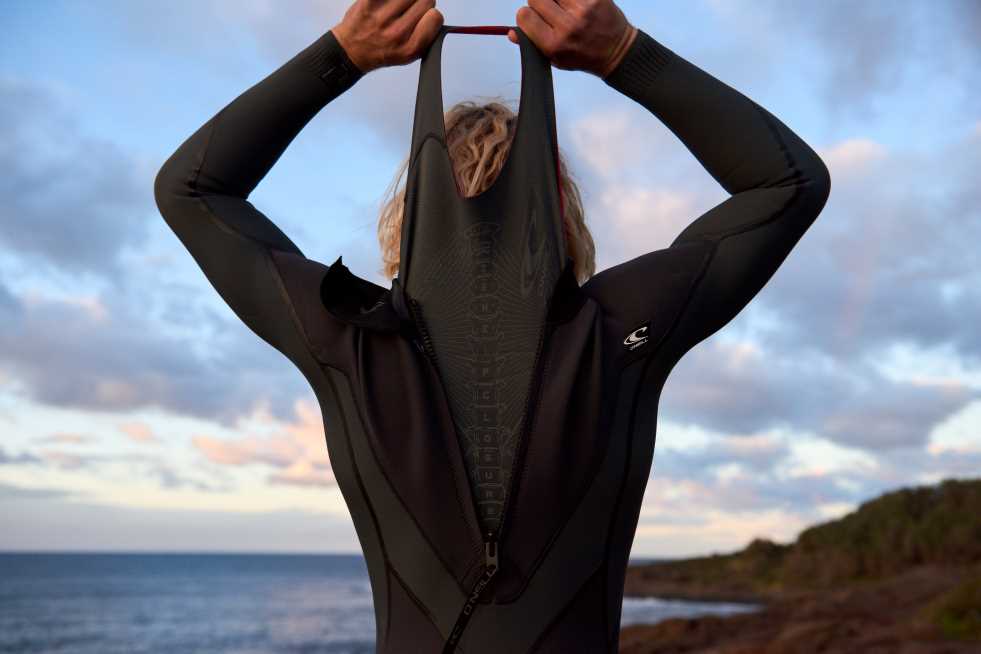
Finding the right size wetsuit can be a little challenging. Every brand has different fits. Therefore, we recommend to first try wetsuits in our shop. Wetsuits come in American sizing for women. A
6’ is an EU 36 in sizing, an
8’ is a 38 and so on. The men's wetsuits come in
XS to 2XL. There are some ‘in between’ sizes for men and women. For the long leg beauties, it would be best to choose a size that comes with a T, for “tall’. You can order a
6T or 8T from different wetsuit brands. For men, you can order an
LS as a wetsuit size, so that you’ll have the large sizing for the shoulders, but the wetsuit will be an S in length. Perfect for the extra V-shaped dudes.
When you aren't able to drop by the shop to try some of our wetsuits, use the following steps to see if the wetsuit has the right fit. Let’s start with putting a wetsuit on in the right way;
How to put on a wetsuit; - Roll the wetsuit down from the neck to the crutch. This way you can easily enter with your legs.
- Put in your legs and roll your wetsuit up to the waistline.
- Check if the knee patches are on your knees and that you don’t have any excess neoprene on your ankles. If so, Gently pull the neoprene up to where it will latch on your body at the right spots.
- Gently pull the wetsuit up to your chest. Then put in the first arm. Pull the suit over the shoulder.
- Put in the second arm. Make sure that there is no excess neoprene on the wrist. If so, gently pull the neoprene up to where it will latch on your arms in the right places.
- Close your back zip, or pull the lip of your front zip over your head en close the front zip.
Things you shouldn’t do while putting on a wetsuit;- Front zip, the neoprene very hard. This will break the rubber
- Neverzip, ll up your wetsuit with your nails. This will break the rubber.
- Never put your back zip in the front of your body. You’ll look like a kook.
Now you have your wetsuit on. Let’s check if you have the right sizing. Here are some ways to see if your wetsuit is too big or too small.
When the wetsuit is too small;- Try to stretch your arm all the way up above your head, like you’re trying to touch the sky. You’ll feel a pull downwards on your shoulders. This means that you don’t have enough room to move around your shoulders.
- The neoprene will shimmer. When you try the wetsuit on, you can notice that the neoprene is stretching too much. When that happens, the neoprene will start to shimmer. This is also an indication that the wetsuit is too small.
When the wetsuit is too big:- Sometimes you’ll see that there is an excessive amount of neoprene on the legs and arms. That can mean that the wetsuit is too long for you.
- If the wetsuit doesn’t latch on to your back. If this happens, there is an air pocket between you and the wetsuit. When this happens, water will be floating freely in your wetsuit. The whole insulation effect of the wetsuit will disappear, and you’ll be cold.
- The neck is too wide. If you can put more than one finger between you and the collar of your wetsuit. That means water can enter too easy and the insulation effect of the wetsuit will disappear.
Quality differences and Terminology
If you're new to the world of surfing and looking for your first, you’ll probably have a hard time with all the terminology. It can sound like abracadabra. Therefore, we’ll explain to you the most important terms to help you decipher the quality differences in wetsuits.
The five biggest quality differences that you need to pay attention to are;- The lining
- The stitching
- The zipper
- The isolation material
- The stretch
The liningAs you might have read in the beginning, we divide neoprene in two different kinds;
Neoprene as synthetic rubber or neoprene foam. In the surf terms, we call the difference single lined and double lined neoprene. Single lining is the synthetic rubber, that is completely water and oil resistant. Single lined neoprene is commonly used on the front and back patches of the wetsuit. These two parts should be the most isolated parts (for your organs) so that you can extend your surf session. The double lined neoprene is the neoprene foam with air pockets.
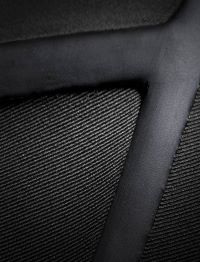
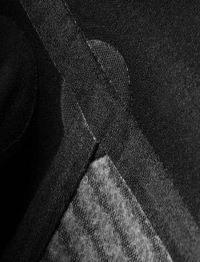
Picture left - Sealed seam ; Right -- taped seam
The stitchingA wetsuit contains of different parts of neoprene (single or double lined) which are stitched together. Water can enter at the stitching, so the way a wetsuit is stitched will tell you something about the warmth or quality of the wetsuit. There are four different ways of stitching; Flat lock, Glued or Blind, Taped or seamed.
The flat lock stitching is the basic stitching. It is the same kind of stitching you’ll see in your clothes. Will let the most amount of water in the wetsuit.
The second stitching is
Glued or Blind stitched (GBS). First, the parts of neoprene will be glued together. After the glue, the neoprene will be stitched together, but without going through the material completely. This makes it a blind stitch. The combination of the glue and blind stitch makes sure that not a lot of water comes through the material, and will isolate better than a flat lock stitch. GBS is the most used stitching within the industry.
The taped seam is a GBS stitch, but with a taped layer over the stitching on most critical parts of the wetsuit. The taped seams are made of an extra layer of neoprene. You’ll see this extra taped seams with the more expensive wetsuit in the highest quality ranges.
The most fancy stitching is a
Sealed seam. The neoprene has been stitched with a GBS stitching, completely layered with single lined neoprene. Te extra rubber makes sure that there is no water coming in or out of the stitching. The sealed seams are only used for winter wetsuits in the highest quality range of different brands.
The zipperOn the wetsuit market we define three different kinds of zippers; The Back-zip, Chest (front) zip or Zip less. Most of the rental wetsuits that you see at surf schools have a back- zip that goes from the neck all the way down the spine. It makes the wetsuit easier to get in or out. The zipper is very wide and thick. Therefore, the wetsuit will not latch as well to the skin and can feel a little stiff. It’s also easier for water to enter the wetsuit, en might be colder in comparison to wetsuits with a front zip or no zip.
The most common zip on a wetsuit is a chest zip, at least for intermediate or advanced surfers. The chest Zip gives you more flexibility and makes sure that your wetsuit fits better on your back. The newest technology is the zip-less wetsuits. This gives you ultimate flexibility and comfort.
Isolation material and Stretch.
Lots of brands are constantly experimenting en optimizing their wetsuits with extra stretch or isolation techniques. The stretch in a wetsuit comes from the amount of spandex that is put in the neoprene foam and gives you the most freedom while surfing. Some brands also developed their own neoprene that has flex and isolation qualities. Check for instance:
